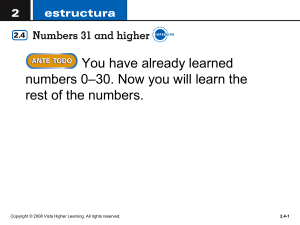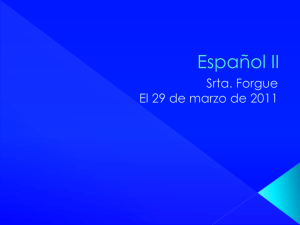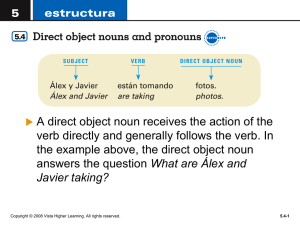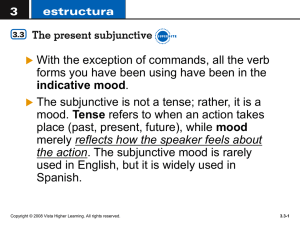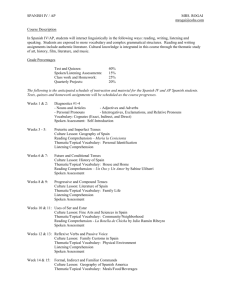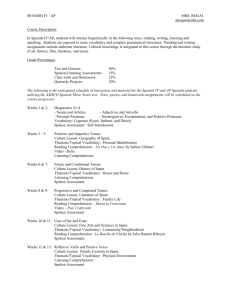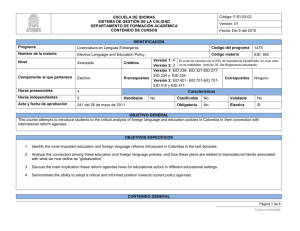REFERENCIAS BIBLIOGRÁFICAS Alianza Futuro Digital Medellín
advertisement
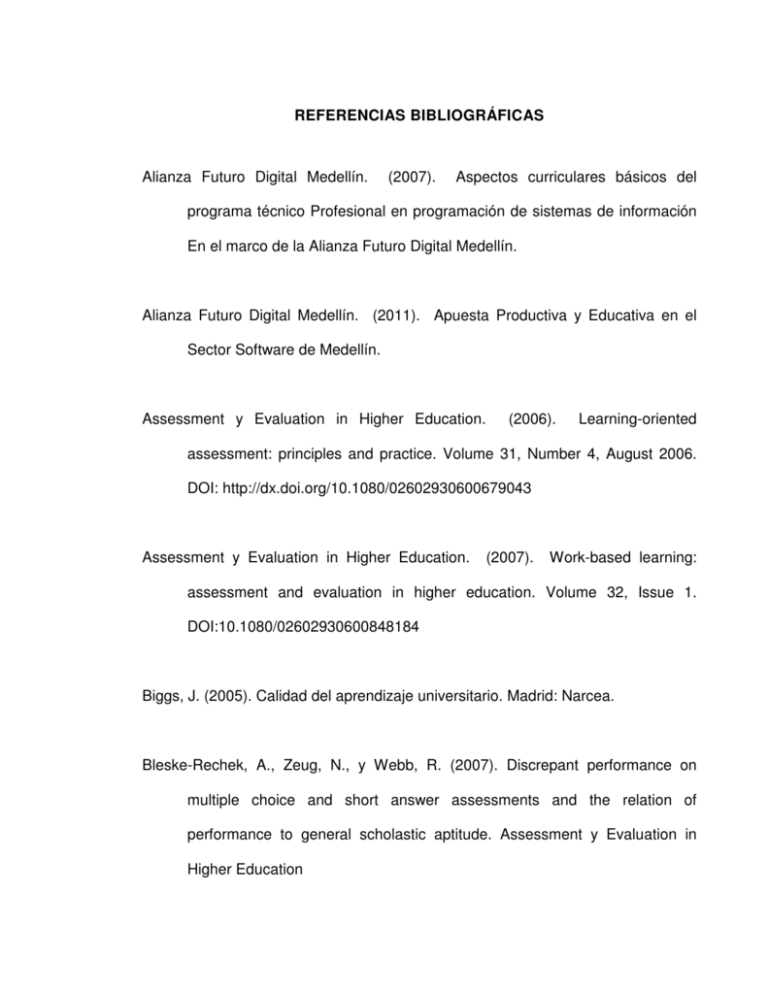
REFERENCIAS BIBLIOGRÁFICAS Alianza Futuro Digital Medellín. (2007). Aspectos curriculares básicos del programa técnico Profesional en programación de sistemas de información En el marco de la Alianza Futuro Digital Medellín. Alianza Futuro Digital Medellín. (2011). Apuesta Productiva y Educativa en el Sector Software de Medellín. Assessment y Evaluation in Higher Education. (2006). Learning-oriented assessment: principles and practice. Volume 31, Number 4, August 2006. DOI: http://dx.doi.org/10.1080/02602930600679043 Assessment y Evaluation in Higher Education. (2007). Work-based learning: assessment and evaluation in higher education. Volume 32, Issue 1. DOI:10.1080/02602930600848184 Biggs, J. (2005). Calidad del aprendizaje universitario. Madrid: Narcea. Bleske-Rechek, A., Zeug, N., y Webb, R. (2007). Discrepant performance on multiple choice and short answer assessments and the relation of performance to general scholastic aptitude. Assessment y Evaluation in Higher Education Bloom, B.J. and Coll. (1979). Handbook on formative and summative evaluation of student learning. McGraw-Hill Book Company, New York. Boud, D., y Falchikov N. (2006). Aligning assessment with long-term learning. Assessment y Evaluation in Higher Education Broabfoot, P., y Black, P. (2004). Redefining assessment? The first ten years of Assessment in Education. Assessment in Education Brodie, P., y Irving, P. (2007). Assessment in work-based learning: investigating a peda-gogical approach to enhance student learning. Assessment y Evaluation in Higher Education Brown, S., y Glasner, A. (2003): Evaluar en la Universidad. Problemas y nuevos enfoques. Madrid: Narcea. Burton, N. (2006). Student justice perceptions following assignment feedback. Assessment y Evaluation in Higher Education Burton, R. (2005). Multiple-choice and true/false tests: myths misapprehensions. Assessment y Evaluation in Higher Education and Burton, R. (2004). Multiple choice and true/false tests: reliability measures and some implications of negative marking. Assessment y Evaluation in Higher Education Campbell, A. (2005). Application of ICT and rubrics to the assessment process where professional judgment is involved: the features of an e-marking tool. Assessment y Evaluation in Higher Education. Cano, M. (1997). Evaluación y educación. Instituto de Investigaciones y Estudios Superiores de las Ciencias Administrativas. Veracruzana. Recuperado Universidad de http://www.uv.mx/iiesca/files/2013/01/evaluacion1997.pdf Carey, J. y Gregory, V. (2003). Toward Improving Student Learning: policy issues and design structures in course level outcomes assessment. Assessment y Evaluation in Higher Education. Carnevale, A. Gainer, L. Meltzer, A. (1990). Workplace Basics The Essential Skills Employers Want, Training Manual. Cassidy, S. (2007). Assessing 'inexperienced' students' ability to self-assess: exploring links with learning style and academic personal control. Assessment y Evaluation in Higher Education. Challis, D. (2005). Committing to quality learning through adaptive online assessment. Assessment y Evaluation in Higher Education. Cheng, D. (2001). Assessing Student Collegiate Experience: where do we begin?. Assessment y Evaluation in Higher Education. Cinterfor/OIT. laboral. (2013). Las 40 preguntas mas frecuentes sobre competencia Recuperado de http://www.oei.org.co/iberfop/documentos/40- ident.pdf Coll, C., Rochera, Mª. J., Mayordomo, R. y Naranjo, M. (2007). Coll, Evaluación continua y ayuda al prendizaje. Una experiencia de innovación en Educación Superior con ayuda de TIC. Electronic Journal of Research in Educational Psychology. Cooper, N. (2000). Facilitating Learning from Formative Feedback in Level 3 Assessment. Assessment y Evaluation in Higher Education. Crème, Ph. (2005). Should student learning journals be assessed?. Assessment y Evaluation in Higher Education. Cronbach, L.J. (1963). college records. Course improvement through evaluation. En teachers Darby, J. (2007). Evaluating course evaluations: the need to establish what is being measured. Assessment y Evaluation in Higher Education. De la Fuente, J. y Justicia, F. (2003). Escala de Estrategias de Aprendizaje ACRA Abreviada para Alumnos Universitarios. Electronic Journal of Research in Educational Psychology. DEPARTAMENTO NACIONAL DE PLANEACIÓN. (2005). Documento CONPES 3360. Bogotá, D.C.: Autor Díaz Barriga, A. (1984). Didáctica y Currículo. Editorial Nuevo Mar. México. Dickinson, M. (2000). An Analysis of the Accreditation of Transferable Skills in Extra Curricular Activities within Higher Education. Assessment y Evaluation in Higher Education. Duncan, N. (2007). 'Feed-forward': improving students' use of tutors' comments. Assessment y Evaluation in Higher Education. Elwood, J., y Val Klenowski (2002). Creating Communities of Shared Practice: the challenges of assessment use in learning and teaching. Assessment y Evaluation in Higher Education. Enriquez, M. (2012). Evaluación Alternativa. Recuperado de http://es.slideshare.net/MagdaBeitler/evaluacion-alternativa-13935939 Fellenz, M. (2004). Using assessment to support higher level learning: the multiple choice item development assignment. Assessment y Evaluation in Higher Education. Forrester-Jones, R., y Hatzidimitriadou, E. (2006). Learning in the real world? Exploring widening participation student views concerning the 'fit' between knowledge learnt and work practices. Assessment y Evaluation in Higher Education. Gamliel, E., y Davidovitz, L. (2005). Online versus traditional teaching evaluation: mode can matter. Assessment y Evaluation in Higher Education. García, I.M. (2010). Sistema de evaluación, Edición electrónica gratuita. Recuperado de www.eumed.net/libros/2010b/687/ Gijbels, D., van de Watering, G., y Dochy, F. (2005). Integrating assessment tasks in a problem-based learning environment. Assessment y Evaluation in Higher Education. Gingerich, W., Kaye, K., y Bailey, D. (1999). Assessing Quality in Social Work Education: focus on diversity. Assessment y Evaluation in Higher Education. González, L. (2003). Aproximación a una formación académica de calidad: el punto de vista de los estudiantes universitarios. Electronic Journal of Research in Educational Psy-chology. Gonzci, A. (1996). “Instrumentación de la educación basada en competencias. Perspectivas de la teoría y práctica en Australia”, en: Competencia Laboral y Educación Basada en Normas de Competencia, México, Limusa. Gosling, D. (2000). Using Habermas to Evaluate Two Approaches to Negotiated Assessment. . Assessment y Evaluation in Higher Education. Hager, P., y Butler, J. (1996). Two Models of Educational Assessment. Assessment y Evaluation in Higher Education Havnes, A. (2004). Examination and learning: an activity-theoretical analysis of the relationship between assessment and educational practice. Assessment y Evaluation in Higher Education. Hosie, P., Schibeci, R., y Backhaus, A. (2005). A framework and checklists for evaluating online learning in higher education. Assessment y Evaluation in Higher Education. International Society for Technology in Education. (2000). National Educational Technology Standards for Students: Connecting Curriculum and Technology. Recuperado de http://eric.ed.gov/?id=ED473132 International Technology Education Association . (1996). Technology for All Americans: A Rationale and Structure for the Study of Technology. Recuperado de http://www.iteea.org/TAA/PDFs/Taa_RandS.pdf International Technology Education Association. (2000). Standards for Technological Literacy: Content for the Study of Technology. Recuperado de http://www.iteaconnect.org/TAA/PDFs/xstnd.pdf Joint comité on Standard for educational evaluation. (1981). Standard for evaluation of educational, projects and materials. Mc Graw Hill, New York. Jones, P, Laufgraben, J., y Morris, N. (2006). Developing an empirically based typology of attitudes of entering students toward participation in learning communities. Assessment y Evaluation in Higher Education. Kemp, E. (1999). Metaphor as a Tool for Evaluation. Assessment y Evaluation in Higher Education. Kempner, K. y Taylor, C. (1998). An alternative assessment to higher education outcomes: Differentiating by institutional type. Higher Education. Keppell, M., Au, E., y Chan, C. (2006). Peer learning and learning-oriented assessment in technology enhanced environments. Assessment y Evaluation in Higher Education. Kirby, N., y Downs, C. (2007). Self-assessment and the disadvantaged student: potential for encouraging self-regulated learning? . Assessment y Evaluation in Higher Education. Klenowski, V., Askew, S., y Carnell, E. (2006). Portfolios for learning, assessment and professional development in higher education. Assessment y Evaluation in Higher Educa-tion. Lundberg, A. (2004). Student and teacher experiences of assessing different levels of understanding. Assessment y Evaluation in Higher Education. MacDonald, B. (1971). The evaluation of the humanities curriculum Project: a holistic approach. The theory into practice, Macdonald, J. (2004). Developing competent e-learners: the role of assessment. Assessment y Evaluation in Higher Education. McDonald, R,; Boud, D.; Francis, J. y Gonczi, A. (2000). Nuevas perspectivas sobre la evaluación. Boletín Cinterfor, 149. Macdonald, R., y Carroll, J. (2006). Plagiarism a complex issue requiring a holistic institutional approach. Assessment y Evaluation in Higher Education. Martínez, J. (2008). Las rúbricas en la evaluación escolar: su construcción y su uso. Recuperado de http://www.humanas.unal.edu.co/psicometria/files/8713/7051/7405/Las_Rbri cas_En_La_Evaluacin_Escolar_-_Su_Construccin_Y_Su_Uso.pdf Mertens, L. (2000). La Gestión por Competencia Laboral en la Empresa y la Formación Profesional. Madrid: Organización de Estados Iberoamericanos para la Educación, la Ciencia y la Cultura (OEI). Recuperado de http://www.oei.es/oeivirt/fp/iberfop01.pdf Mertler, C. (2001). Diseño de rúbricas de evaluación para su clase. Green State University. Recuperado digital.itcr.ac.cr/servicios/boletin/?q=diseno_rubricas de Bowling http://www.tec- Ministerio de Educación Nacional. (2012). La valuación en el aula. Recuperado de http://www.mineducacion.gov.co/1621/w3-article-236979.html . Ministerio de Educación Nacional. (2010). Política pública sobre educación superior por ciclos secuenciales y complementarios (propedéuticos). Documento de Discusión Versión. Mayo de 2010. Recuperado de http://www.mineducacion.gov.co/articles239511_archivo_pdf_politica_ciclos.pdf National Business Education Association. (1995). National Standards for Business Education: What America's Students Should Know and Be Able To Do in Business. National Business Education Association. National Commission on Excellence in Education (1983) A Nation at Risk. Recuperado de www.ed.gov/pubs/NatAtRisk O'Connell, T., y Dyment, J. (2006). Reflections on using journals in higher education: a focus group discussion with faculty. Assessment y Evaluation in Higher Education. Parra, C. (2009). Evaluación por competencias propuesta desde el decreto 1290. Alianza Futuro Digital Medellín. Poblete, M. (2005). Evaluación de competencias en la educación superior. Preguntas clave que sobre evaluación de competencias se hacen los profesores. Tentativas de respuesta. Universidad de Deusto. Recuperado de http://paginaspersonales.deusto.es/mpoblete2/PONENCIA01.htm Prins, F., Sluijsmans, D., Kirschner, P., y Strijbos, J. (2005). Formative peer assessment in a CSCL environment: a case study. Assessment y Evaluation in Higher Education. Quijano, M. (2003). Propuesta modelo de evaluación por competencias. Revista Escuela de Administración de Negocios. Recuperado de http://journal.ean.edu.co/index.php/Revista/issue/view/20 Ravitch, Diane (1996), Estándares nacionales en educación, Santiago de Chile, Programa de Promoción de la Reforma Educativa en América Latina y el Caribe (PREAL). Recuperado de http://www.oei.es/evaluacioneducativa/estandares_nacionales_educacion_r avitch.pdf Richardson, J. (2005). Instruments for obtaining student feedback: a review of the literature. Assessment y Evaluation in Higher Education. Rosero, C. (2012). Estrategia metodológica para el seguimiento al desarrollo de competencias en estudiantes de la media técnica del proyecto Alianza Futuro Digital Medellín (AFDM). (Tesis de Maestría). Disponible en http://hdl.handle.net/10784/705 Ruíz Iglesias, M. (2008). Maestría internacional de competencias profesionales. La evaluación de competencias. Universidad Autónoma de Nuevo León/ Universidad de La Mancha, Castilla. Recuperado de http://servicios.encb.ipn.mx/tutorias/formatos/lectura_tuto/la%20evaluaci%c 3%93n%20de%20competencias.pdf Ruíz Iglesias, M. (2009). Congreso Evaluación por competencias. Educativo Formando Formadores Recursos del Primer "Hay Talento 2009". Recuperado de http://www.cca.org.mx/profesores/congreso_recursos/ Rust, C., O'Donovan, B., y Price, M. (2005). A social constructivist assessment process model: how the research literature shows us this could be best practice. Assessment y Evaluation in Higher Education. Santos, M. (2006). Dominicano. Evaluación Formativa. Educando Portal de Educación Recuperado http://www.educando.edu.do/articulos/docente/evaluacin-formativa/ de Schelfhout, W., Dochy, F., y Janssens, S. (2004). The use of self, peer and teacher assessment as a feedback system in a learning environment aimed at fostering skills of cooperation in an entrepreneurial context. Assessment y Evaluation in Higher Education. Scriven, M. (1967). The methodology of evaluation. En Stake, R. E. Aera Monograph series curriculum evaluation. Randa Mc Nally, Chicago. Secretary's Commission on Achieving Necessary Skills. Requires of School. (1991). What Work Recuperado de http://wdr.doleta.gov/SCANS/whatwork/ Segers, M., y Dochy, F. (1996). Quality assurance in higher education: theoretical considerations and empirical evidence. Studies in Educational Evaluation. SENA. (2003). Formación por Competencias Laborales empieza a ser realidad. Fuente: NOTISENA, no. 4. Disponible en Internet http://www.cinterfor.org.uy/ SENA. (2003). Dirección general de Formación para el trabajo. ABC de las Competencias. Cartilla 1 Colombia. Recuperado de http://www.redes- cepalcala.org/inspector/documentos%20y%20libros/competencias/abc%20d e%20las%20competencias.pdf Silén, Ch. (2006). The Tutor’s Approach in Base Groups (PBL). Higher Education. Smith, K., y Tillema, H. (2003). Clarifying different types of portfolio use. Assessment y Evaluation in Higher Education. Smyth, K. (2004). The benefits of students learning about critical evaluation rather than being summatively judged. Assessment y Evaluation in Higher Education. Starr-Glass, D. (2005). Metaphors and maps in evaluation. Assessment y Evaluation in Higher Education. Stowell, M. (2004).Equity, justice and standards: assessment decision making in higher education. Assessment y Evaluation in Higher Education. Struyven, K., Dochy, K., y Janssens, S. (2005). Students' perceptions about evaluation and assessment in higher education: a review. Assessment y Evaluation in Higher Education. Stufflebeam, D. L. (1971). Educational evaluation and decision making. Ithaca, III: F.E. Peacock phi delta Kappastudy national study committee on evaluation. Sullivan, K. (2002). Credit and Grade Transfer within the European Union's SOCRATES Programme: unity in diversity or head in the sand?. Assessment y Evaluation in Higher Education. TAMAYO, M. (2000). El Proceso de Investigación Científica. Editores Noriega. México. Taras, M. (2001). The Use of tutor feedback and student self-assessment in summative assessment tasks: towards transparency for students and for tutors. Assessment y Evaluation in Higher Education. Taras, M. (2002). Using assessment for learning and learning from assessment. Assessment y Evaluation in Higher Education. Taras, M. (2003). To feedback or not to feedback in student self-assessment. Assessment y Evaluation in Higher Education. Toohey, S. (2002). Assessment of students' personal development as part of preparation for professional work is it desirable and is it feasible?. Assessment y Evaluation in Higher Education. Torrano, F. y González, M. (2004). El aprendizaje autorregulado: presente y futuro de la investigación, Electronic Journal of Research in Educational Psychology. Tuning América Latina (2007). Proyecto Tuning. Reflexiones y Perspectivas de laEducación Superior en América Latina – América Latina 2004-2007. Recuperado de (http://tuning.unideusto.org/tuningal/index.php?option=com_docman&Itemid =191&task=view_category&catid=22&order=dmdate_published&ascdesc=D ESC. Acceso abril 30 de 2010. Tyler, R.W. (1949). Principios básicos del currículo. Troquel. Buenos Aires. Van Eekelen, I., Boshuizen, H. y Vermunt, J. (2005). Self-regulation in Higher Education Teacher Learning. Higher Education. Walsh, A. (2007). An exploration of Biggs' constructive alignment in the context of work-based learning. Assessment y Evaluation in Higher Education. Watt, S., Simpson, C., McKillop, Ch., y Nunn, V. (2002). Electronic Course Surveys: does automating feedback and reporting give better results?. Assessment y Evaluation in Higher Education. Weaver, M. (2006). Do students value feedback? Student perceptions of tutors' written responses. Assessment y Evaluation in Higher Education. Welsh, J., Alexander, S., y Dey, S. (2001). Continuous Quality Measurement: restructuring assessment for a new technological and organizational environment. Assessment y Evaluation in Higher Education. Wilson, K., y Fowler, J. (2005). Assessing the impact of learning environments on students' approaches to learning: comparing conventional and action learning designs. Assessment y Evaluation in Higher Education. Wilson, M y Scalise, K. (2006). Assessment to improve learning in higher education: The BEAR Assessment System. Higher Education. Winning, T., Lim, E., y Townsend, G. (2005). Student experiences of assessment in two problem-based dental curricula: Adelaide and Dublin. Assessment y Evaluation in Higher Education. Winter, R. (1994). Work-based Learning and Quality Assurance in Higher Education. Assessment y Evaluation in Higher Education. Woodward, H. (1998). Reflective Journals and Portfolios: learning through assessment. Assessment y Evaluation in Higher Education. Woodward, H. y Nanlohy, Ph. (2004). Digital portfolios: fact or fashion?. Assessment y Evaluation in Higher Education. Woolf, H. (2004). Assessment criteria: reflections on current practices. Assessment y Evaluation in Higher Education. . Zakrzewski, S., y Bull, J. (1998). The mass implementation and evaluation of computer-based Education. assessments. Assessment y Evaluation in Higher
